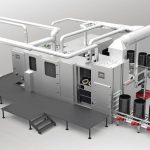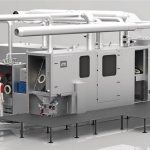In the course of 2016, Dinnissen’s specialists set to work on a fully 3D-animated pre-engineering draft in regular consultation with the client in preparation for the first designs. One of the concepts they came up with was exactly what the customer was looking for and at the end of 2016, Dinnissen was awarded the contract. This marked the beginning of a process of adaptations, improvements and innovations. Early in 2018, after more than a year of development, testing and optimisation, the custom-built automatic drum emptier was a fact. In the first step, the closed drums are supplied and placed on the roller conveyor by the operator. Following the enable signal and confirmation that the system is ready, the drum is transported to the first cabin.
Opening
During the first operation, the lid is removed from the drum fully automatically with a special head piece, in which the lid remains clamped. The drum passes through an airlock to the second cabin. In the meantime, the clamped lid is pushed out of the head piece and placed on another conveyor belt. It is taken to a separate cabin and cleaned with a neutral liquid, to enable it to be safely removed from the system.
The drum now arrives at the second cabin with the lid removed. As some drums have a separate inliner (a plastic lining on the inside), provision had to be made for it to be removed easily by the operator. For this reason, the second cabin features a special hatch which allows access not only to the inliner but also for removing any powder residue. For even better accessibility as well as faster, more efficient working, the drum is positioned on a turntable.
Emptying
In the next step, the drum – which is still filled – is transported on another roller conveyor to the third cabin, where it is fixed by a gripper arm which rotates and empties it. At the express request of the client, this arm can be steplessly controlled and requires two-hand operation. This is a major advantage since it allows the operator to look inside the rotating drum and assess whether a specially positioned beater is necessary to remove powder residues. Any powder chunks are reduced in size by a breaking knife developed in-house.
The inliner (if any) and the powder continue on their way, the inliner being automatically transported to a shredder and shredded. The flakes could still be contaminated with the toxic or explosive residual product, which is why they are stored in a special container that is eventually filled with a cleaning liquid. After a certain time, this liquid is drained and the flakes can be repacked and safely disposed of.
Cleaning
After emptying, the drum is returned to the starting position with the same two-handed control and transported to the cleaning cabin on the roller conveyor. It is clamped there fully automatically, then lifted, turned over, moved into the desired cleaning position, rinsed with a large amount of liquid, blown dry with compressed air and placed back on the conveyor. The clean drum is now ready to be automatically released via a secure hatch.
Added safety
To create added safety, each cabin is regarded as an isolated space which can be locked securely with its own automatic doors or shutters. If required, the operator can inject nitrogen into any cabin containing potentially explosive products to rule out the risk of explosion. The system is also equipped with a built-in air dryer, including filters to prevent vapours from spreading. Another similarly innovative feature is the constant negative pressure, which prevents toxic or explosive vapours from escaping when the drums are introduced or released.
The complete electronic control and monitoring technology, including all visualisation functions, was developed and implemented by Dinnissen.
Online search: cpp0318dinnissen








